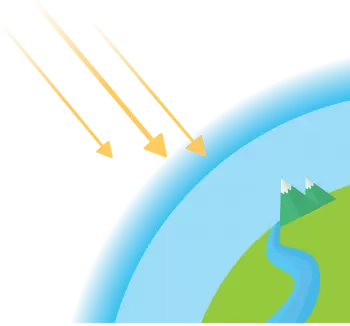
The atmosphere is a layer of gases that surrounds any celestial body. In our case, the Earth's atmosphere is the envelope of gas that surrounds the surface of planet Earth.
It is composed of 78% nitrogen, 21% oxygen and the rest of argon, carbon dioxide and traces of other elements. Water vapor is added to these gases, the percentage of which is quite variable and can reach up to 6%.
The weight of all these compounds is what causes atmospheric pressure, therefore, the atmospheric pressure will be maximum on the earth's surface.
This gaseous layer is divided into several layers of different thickness, depending on the temperature trend. The layers that make up the atmosphere are the following:
The troposphere
It is the lowest layer of the Earth's atmosphere in which we are immersed, being in contact with the Earth's surface. Life on the planet develops within the troposphere. It is here that the various gases have the highest concentration.
The importance of the gases in this layer is that they cause a greenhouse effect necessary for life on Earth. This effect consists of capturing part of the solar rays that bounce off the earth's surface and that the planet's temperature does not cool down.
The thickness of the troposphere varies from about 10 km above the poles to 20 km near the equator. The troposphere is heated by heat from the Earth's surface and its temperature decreases as it rises along a vertical thermal gradient equal to 0.6 ° C per 100 meters. Meteorological phenomena such as wind, cloud formation, precipitation occur in the troposphere.
The stratosphere
The stratosphere is the next layer of the atmosphere and extends up to 50 kilometers high. Water vapor is almost absent and gases are much more rarefied than those in the troposphere.
The temperature increases with increasing altitude, due to the presence, around 40 km, of an ozone layer. Ozone has the property of absorbing ultraviolet radiation (ultraviolet rays), producing heat, and protecting radiation that is harmful to life on Earth.
In this second layer of the atmosphere there are also pearly clouds formed by ice crystals and dust.
The mesosphere
In this layer, which reaches up to 80 km in altitude, the temperature begins to drop as the height increases.
A key feature of the mesosphere is the extreme rarefaction of the elements.
In this layer originate the "shooting stars", that is, the small fragments of meteorites that burn before reaching the Earth, leaving trails of light.
Thermosphere
The temperature of the thermosphere, which extends over 500 km, increases with increasing height.
In the thermosphere there is an area, called the ionosphere, characterized by the presence of electrically charged particles (ions). These ions are formed by the cleavage of gaseous elements by cosmic rays from other stars and from the Sun. Polar auroras can occur in this layer.
Numerous artificial satellites and the international space base orbit in the highest part of the thermosphere.
The exosphere
It represents the outermost layer of the atmosphere and has no real upper limit, gradually fading into interplanetary outer space.
The few gaseous elements are light molecules like hydrogen and helium present in extremely low percentages.